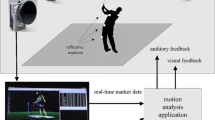Abstract
Divers methods to train motions exist in multiple domains such as sports, rehabilitation or in industrial use cases. With regard to findings considering imitation learning in real world scenarios and social interaction guidelines in extended realities (XR), in this paper the transferability of these real world effects to AR is investigated within an assembly scenario. On that basis, a comparative user study (N = 12) was conducted analysing implicit imitation learning as well as the impact on the performance. Therefore, besides the measurement of the completion time, motion data are captured and a first analysis of the data is conducted. Whereas in terms of the cumulative completion time, no significant differences between trained and untrained subjects can be measured, the avatar’s motion was imitated differently between the groups. More precise, for the similarity of motion pattern between the avatar’s motion and the motion of the subjects it was shown that the untrained imitated the motions significantly more often than the trained, but both groups imitated in general. The results provide a first insight of the possibilities and limits of imitation learning in AR. With respect to the specific assembly use case, an avatar assistance method could enhance the learning, considering performance parameters and could lead to an implicit imitation of ergonomic motion patterns while having free cognitive capacity for conducting the specific processes.
Access this chapter
Tax calculation will be finalised at checkout
Purchases are for personal use only
Similar content being viewed by others
References
Anderson, F., Grossman, T., Matejka, J., Fitzmaurice, G.: YouMove: enhancing movement training with an augmented reality mirror. In: Proceedings of the 26th Annual ACM Symposium on User Interface Software and Technology - UIST 2013, pp. 311–320. ACM Press (2013). https://doi.org/10.1145/2501988.2502045
Chen, X., et al.: ImmerTai: immersive motion learning in VR environments 58, 416–427. https://doi.org/10.1016/j.jvcir.2018.11.039
Funk, M., Kosch, T., Greenwald, S.W., Schmidt, A.: A benchmark for interactive augmented reality instructions for assembly tasks. In: Proceedings of the 14th International Conference on Mobile and Ubiquitous Multimedia - MUM 2015, pp. 253–257. ACM Press. https://doi.org/10.1145/2836041.2836067
Ganier, F.: Factors affecting the processing of procedural instructions: implications for document design 47(1), 15–26. https://doi.org/10.1109/TPC.2004.824289
Guadagno, R.E., Blascovich, J., Bailenson, J.N., Mccall, C.: Virtual humans and persuasion: The effects of agency and behavioral realism, p. 22 (2007)
Han, P.H., Chen, K.W., Hsieh, C.H., Huang, Y.J., Hung, Y.P.: AR-arm: augmented visualization for guiding arm movement in the first-person perspective. In: Proceedings of the 7th Augmented Human International Conference 2016 on AH 2016, pp. 1–4. ACM Press (2016). https://doi.org/10.1145/2875194.2875237
Kim, K., Billinghurst, M., Bruder, G., Duh, H.B.L., Welch, G.F.: Revisiting trends in augmented reality research: a review of the 2nd decade of ISMAR (2008–2017) 24(11), 2947–2962. https://doi.org/10.1109/TVCG.2018.2868591
Kim, K., Boelling, L., Haesler, S., Bailenson, J., Bruder, G., Welch, G.F.: Does a digital assistant need a body? The influence of visual embodiment and social behavior on the perception of intelligent virtual agents in AR. In: 2018 IEEE International Symposium on Mixed and Augmented Reality (ISMAR), pp. 105–114. IEEE (2018). https://doi.org/10.1109/ISMAR.2018.00039
Kim, K., Maloney, D., Bruder, G., Bailenson, J.N., Welch, G.F.: The effects of virtual human’s spatial and behavioral coherence with physical objects on social presence in AR: Virtual human’s spatial and behavioral coherence in AR 28(3), e1771. https://doi.org/10.1002/cav.1771
Kosch, T., Funk, M., Schmidt, A., Chuang, L.L.: Identifying cognitive assistance with mobile electroencephalography: a case study with in-situ projections for manual assembly 2, 1–20. https://doi.org/10.1145/3229093
Lampen, E., Teuber, J., Gaisbauer, F., Bär, T., Pfeiffer, T., Wachsmuth, S.: Combining simulation and augmented reality methods for enhanced worker assistance in manual assembly 81, 588–593. https://doi.org/10.1016/j.procir.2019.03.160
Limbu, B.H., Jarodzka, H., Klemke, R., Specht, M.: Using sensors and augmented reality to train apprentices using recorded expert performance: a systematic literature review 25, 1–22. https://doi.org/10.1016/j.edurev.2018.07.001
Miller, M.R., Jun, H., Herrera, F., Yu Villa, J., Welch, G., Bailenson, J.N.: Social interaction in augmented reality 14(5), e0216290. https://doi.org/10.1371/journal.pone.0216290
Deutsches Institut für Normung, e.V.: DIN CEN ISO/TR 7250–2: Wesentliche Maße des menschlichen Körpers für die technische Gestaltung Teil 2. Anthropometrische Datenbanken einzelner nationaler Bevölkerungen. https://doi.org/10.31030/1935074
Patterson, R.E., Pierce, B.J., Bell, H.H., Klein, G.: Implicit learning, tacit knowledge, expertise development, and naturalistic decision making 4(4), 289–303. https://doi.org/10.1177/155534341000400403
Rizzolatti, G., Fogassi, L., Gallese, V.: Neurophysiological mechanisms underlying the understanding and imitation of action 2(9), 661–670. https://doi.org/10.1038/35090060
Schaal, S., Ijspeert, A., Billard, A.: Computational approaches to motor learning by imitation 358(1431), 537–547. https://doi.org/10.1098/rstb.2002.1258
Schepers, M., Giuberti, M., Bellusci, G.: Xsens MVN: Consistent tracking of human motion using inertial sensing. https://doi.org/10.13140/rg.2.2.22099.07205
Snoddy, G.S.: Learning and stability: a psychophysiological analysis of a case of motor learning with clinical applications 10(1), 1–36. https://doi.org/10.1037/h0075814
Waltemate, T., Gall, D., Roth, D., Botsch, M., Latoschik, M.E.: The impact of avatar personalization and immersion on virtual body ownership, presence, and emotional response 24(4), 1643–1652. https://doi.org/10.1109/TVCG.2018.2794629
Webel, S., Bockholt, U., Engelke, T., Gavish, N., Tecchia, F.: Design recommendations for augmented reality based training of maintenance skills. In: Alem, L., Huang, W. (eds.) Recent Trends of Mobile Collaborative Augmented Reality Systems, pp. 69–82. Springer, New York (2011). https://doi.org/10.1007/978-1-4419-9845-3_5
Acknowledgement
The authors acknowledge the financial support by the Federal Ministry of Education and Research of Germany (MOSIM project, grant no. 01IS18060A-H).
Author information
Authors and Affiliations
Corresponding author
Editor information
Editors and Affiliations
Rights and permissions
Copyright information
© 2020 Springer Nature Switzerland AG
About this paper
Cite this paper
Lampen, E., Liersch, M., Lehwald, J. (2020). Towards Motor Learning in Augmented Reality: Imitating an Avatar. In: Stephanidis, C., Antona, M., Ntoa, S. (eds) HCI International 2020 – Late Breaking Posters. HCII 2020. Communications in Computer and Information Science, vol 1294. Springer, Cham. https://doi.org/10.1007/978-3-030-60703-6_23
Download citation
DOI: https://doi.org/10.1007/978-3-030-60703-6_23
Published:
Publisher Name: Springer, Cham
Print ISBN: 978-3-030-60702-9
Online ISBN: 978-3-030-60703-6
eBook Packages: Computer ScienceComputer Science (R0)




